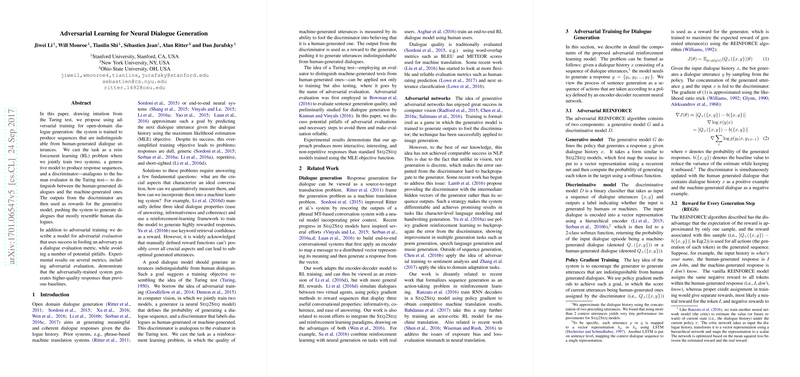Adversarial Learning for Neural Dialogue Generation
This paper presents a novel approach to open-domain dialogue generation through adversarial training, drawing inspiration from the Turing test. The authors propose casting the dialogue generation task as a reinforcement learning (RL) problem, wherein a generative model produces response sequences and a discriminator, analogous to the human evaluator in the Turing test, distinguishes between human-generated and machine-generated dialogues. The discriminator's output serves as a reward for the generative model, incentivizing it to produce sequences that closely resemble human dialogues.
Key Contributions
- Adversarial Training Framework:
- The paper leverages the adversarial training (AT) paradigm, akin to Generative Adversarial Networks (GANs) in computer vision, for dialogue generation. Here, two models— a generator and a discriminator— are trained jointly. The generator attempts to produce human-like dialogues, while the discriminator aims to differentiate between real and generated dialogues.
- Formulating the process as a reinforcement learning problem, the generator's performance is measured by its ability to deceive the discriminator, receiving guidance through a reward feedback mechanism.
- Adversarial Evaluation:
- The proposed model includes an adversarial evaluation component, leveraging a similar adversarial setup. The discriminator's role here extends to evaluating the quality of generated dialogues by assessing their "humanness."
- This method aims to mitigate potential pitfalls associated with traditional evaluation metrics, which are often insufficient for capturing the nuanced aspects of dialogue quality.
Experimental Results
The results encompass several evaluation metrics, demonstrating the effectiveness of the adversarial approach over conventional dialogue generation models trained via Maximum Likelihood Estimation (MLE):
- Response Quality: The adversarially trained model outperformed standard baselines, generating responses that were described as more interactive, interesting, and non-repetitive.
- Adversarial Success (AdverSuc): The authors introduced AdverSuc as a performance metric, representing the fraction of times the generator successfully fooled the discriminator. The proposed model achieved higher AdverSuc scores compared to the baselines.
- Human Evaluation: Crowdsourced human judges were asked to compare the outputs of the adversarial model against a strong mutual information reranking baseline. The evaluations indicated significant improvements in both single-turn and multi-turn dialogue quality.
Implications and Future Directions
The theoretical and practical implications of this research are profound:
- Enhanced Training Objectives: By aligning the training objectives with the desired outcome (human-like dialogues), the adversarial approach bridges the gap left by manually defined reward functions in traditional RL frameworks.
- Generalization to Other NLP Tasks: Although the primary focus is on dialogue generation, the adversarial training methodology has the potential to benefit other NLP tasks where there exists a significant discrepancy between model-generated outputs and real-world data.
Conclusion
This work advances the state of neural dialogue generation by introducing a robust adversarial training framework, validated by comprehensive experiments and human evaluations. It demonstrates that by leveraging adversarial principles, models can be trained to produce more human-like, engaging, and contextually appropriate dialogue responses. The promising results open new avenues for research, particularly in exploring the applicability of adversarial learning across diverse NLP tasks and further refining discriminator models to enhance the evaluator's reliability and generalization capabilities.
